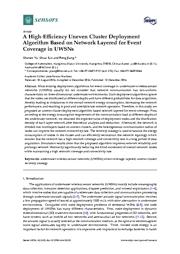A High-Efficiency Uneven Cluster Deployment Algorithm Based on Network Layered for Event Coverage in UWSNs
Shanen Yu, Shuai Liu, Peng Jiang
2016
Sensors
Most existing deployment algorithms for event coverage in underwater wireless sensor networks (UWSNs) usually do not consider that network communication has non-uniform characteristics on three-dimensional underwater environments. Such deployment algorithms ignore that the nodes are distributed at different depths and have different probabilities for data acquisition, thereby leading to imbalances in the overall network energy consumption, decreasing the network performance, and resulting in
more »
... r and unreliable late network operation. Therefore, in this study, we proposed an uneven cluster deployment algorithm based network layered for event coverage. First, according to the energy consumption requirement of the communication load at different depths of the underwater network, we obtained the expected value of deployment nodes and the distribution density of each layer network after theoretical analysis and deduction. Afterward, the network is divided into multilayers based on uneven clusters, and the heterogeneous communication radius of nodes can improve the network connectivity rate. The recovery strategy is used to balance the energy consumption of nodes in the cluster and can efficiently reconstruct the network topology, which ensures that the network has a high network coverage and connectivity rate in a long period of data acquisition. Simulation results show that the proposed algorithm improves network reliability and prolongs network lifetime by significantly reducing the blind movement of overall network nodes while maintaining a high network coverage and connectivity rate. Sensors 2016, 16, 2103 2 of 18 aqueous environments [13, 14] . Therefore, in this study, energy consumption efficiency is a critical target for UWSNs node deployment. Usually, the relay and transmission direction in UWSNs is down-to-up [15, 16] . As shown in Figure 1 , the individual nodes in different depths of water will bear different opportunities to send and receive a message. If the node is closer to the water surface, then its energy consumption is faster and eventually leads to premature death. Local network coverage holes and disconnection of communication links during network operation reduces the performance of coverage and connectivity until the entire monitoring network eventually fails. However, many researchers have begun to investigate uneven node deployment strategy based on event coverage. and consume more energy if the node close to the water surface sinks, thus leading to different distributions of energy consumption at different underwater depths and to imbalances between the energy consumption of each layer network. The network communication links near the water surface disconnect easily during period of network operation, thus influencing data acquisition and decreasing network lifetime. Regarding aforementioned problems of deployment algorithms based the event coverage, in this study, we proposed an uneven cluster deployment algorithm based network layered (UCBNL) for event coverage in UWSNs. According to the monitoring of water environments under the random distribution of isolated event information, node deployment should guarantee real-time collection of event information and ensure that the final data transmission to the surface sink nodes set. In other words, we should ensure high network coverage rate to improve network connectivity rate while effectively conserving node energy and balancing global network energy consumption. Based on the characteristics of UWSNs data acquisition (down-to-up) in underwater environments, we proposed UCBNL algorithm comprising two parts. First, we use hierarchical static deployment based on probability theory and mathematical statistics analysis, where each layer node deployment expectation is calculated to meet the network performance quality of UWSNs and parameters of deployment density are adjusted accordingly. Second, the uneven deployment method was proposed for the communication load distribution and connectivity or coverage deployment requirements of each node. This method narrows the move range of nodes and increases the size of the node density and cluster number of each layer if they are closer to the sink node of the water surface. Thus, we obtain the capabilities of a temporary fix node, conserve the movement energy and deployment time, and balance the energy consumption of nodes in each layer. Simulation results show that the UCBNL algorithm can maintain high network coverage and connectivity rates for a long period of time, reduce network energy consumption, and decrease the slope of network recession, thereby prolonging network lifetime. Compared with existing deployment algorithms for event coverage in UWSNs, our proposed algorithm contributes the following:
doi:10.3390/s16122103
pmid:27973448
pmcid:PMC5191083
fatcat:v2srovkiifdmrclo3mlg77jygm

